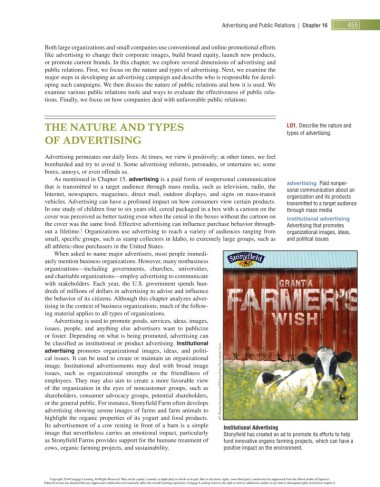Page 488 - Foundations of Marketing
P. 488
Advertising and Public Relations | Chapter 16 455
Both large organizations and small companies use conventional and online promotional efforts
like advertising to change their corporate images, build brand equity, launch new products,
or promote current brands. In this chapter, we explore several dimensions of advertising and
public relations. First, we focus on the nature and types of advertising. Next, we examine the
major steps in developing an advertising campaign and describe who is responsible for devel-
oping such campaigns. We then discuss the nature of public relations and how it is used. We
examine various public relations tools and ways to evaluate the effectiveness of public rela-
tions. Finally, we focus on how companies deal with unfavorable public relations.
THE NATURE AND TYPES LO 1 . Describe the nature and
types of advertising.
OF ADVERTISING
Advertising permeates our daily lives. At times, we view it positively; at other times, we feel
bombarded and try to avoid it. Some advertising informs, persuades, or entertains us; some
bores, annoys, or even offends us.
As mentioned in Chapter 15 , advertising is a paid form of nonpersonal communication
advertising Paid nonper-
that is transmitted to a target audience through mass media, such as television, radio, the
sonal communication about an
Internet, newspapers, magazines, direct mail, outdoor displays, and signs on mass-transit
organization and its products
vehicles. Advertising can have a profound impact on how consumers view certain products. transmitted to a target audience
In one study of children four to six years old, cereal packaged in a box with a cartoon on the through mass media
cover was perceived as better tasting even when the cereal in the boxes without the cartoon on institutional advertising
the cover was the same food. Effective advertising can influence purchase behavior through- Advertising that promotes
2
out a lifetime. Organizations use advertising to reach a variety of audiences ranging from organizational images, ideas,
small, specific groups, such as stamp collectors in Idaho, to extremely large groups, such as and political issues
all athletic-shoe purchasers in the United States.
When asked to name major advertisers, most people immedi-
ately mention business organizations. However, many nonbusiness
organizations—including governments, churches, universities,
and charitable organizations—employ advertising to communicate
with stakeholders. Each year, the U.S. government spends hun-
dreds of millions of dollars in advertising to advise and influence
the behavior of its citizens. Although this chapter analyzes adver-
tising in the context of business organizations, much of the follow-
ing material applies to all types of organizations.
Advertising is used to promote goods, services, ideas, images,
issues, people, and anything else advertisers want to publicize
or foster. Depending on what is being promoted, advertising can
be classified as institutional or product advertising. Institutional
advertising promotes organizational images, ideas, and politi-
cal issues. It can be used to create or maintain an organizational
image. Institutional advertisements may deal with broad image
issues, such as organizational strengths or the friendliness of
employees. They may also aim to create a more favorable view AP Photo/Anonymous/PRNewsFoto/Stonyfield Farm
of the organization in the eyes of noncustomer groups, such as
shareholders, consumer advocacy groups, potential shareholders,
or the general public. For instance, Stonyfield Farm often develops
advertising showing serene images of farms and farm animals to
highlight the organic properties of its yogurt and food products.
Its advertisement of a cow resting in front of a barn is a simple Institutional Advertising
image that nevertheless carries an emotional impact, particularly Stonyfield has created an ad to promote its efforts to help
as Stonyfield Farms provides support for the humane treatment of fund innovative organic farming projects, which can have a
cows, organic farming projects, and sustainability. positive impact on the environment.
Copyright 2014 Cengage Learning. All Rights Reserved. May not be copied, scanned, or duplicated, in whole or in part. Due to electronic rights, some third party content may be suppressed from the eBook and/or eChapter(s).
Editorial review has deemed that any suppressed content does not materially affect the overall learning experience. Cengage Learning reserves the right to remove additional content at any time if subsequent rights restrictions require it.

